Tamilnadu State Board New Syllabus Samacheer Kalvi 8th Maths Guide Pdf Chapter 4 Life Mathematics Ex 4.3 Text Book Back Questions and Answers, Notes.
Tamilnadu Samacheer Kalvi 8th Maths Solutions Chapter 4 Life Mathematics Ex 4.3
Question 1.
Fill in the blanks:
(i) The compound interest on ₹ 5000 at 12% p.a for 2 years, compounded annually is ________ .
Answer:
₹ 1272
Hint:
Compound Interest (CI) formula is
CI = Amount – Principal

∴ 6272 – 5000 = ₹ 1272
![]()
(ii) The compound interest on ₹8000 at 10% p.a for 1 year, compounded half yearly is ________ .
Answer:
₹ 820
Hint:
Compound interest (CI) = Amount – Principal
Amount = p \(\left(1+\frac{r}{100}\right)^{2 n}\) [2n as it is compounded half yearly]
r = 10% p.a, for half yearly r = \(\frac{10}{2}\) = 5
∴ A = 8000 \(\left(1+\frac{5}{100}\right)^{2 \times 1}\) = 8000 × \(\left(\frac{105}{100}\right)^{2}\) = 8820
CI = Amount – principal = 8820 – 8000 = ₹ 820
(iii) The annual rate of growth in population of a town is 10%. If its present population is 26620, then the population 3 years ago was ________ .
Answer:
₹ 20,000
Hint:
Rate of growth of population r = 10%
Present population = 26620
Let population 3 years ago be x
∴ Applying the formula for population growth which is similar to compound interest,
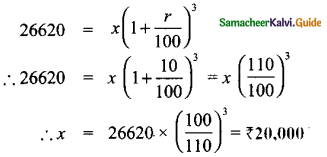
The population 3 years ago was ₹ 20,000
![]()
(iv) If the compound interest is calculated quarterly, the amount is found using the formula ________ .
Answer:
A = \(P\left(1+\frac{r}{400}\right)^{4 n}\)
Hint:
Quarterly means 4 times in a year.
∴ The formula for compound interest is
A = \(P\left(1+\frac{r}{400}\right)^{4 n}\)
(v) The difference between the C.I and S.I for 2 years for a principal of ₹ 5000 at the rate of interest 8% p.a is ________ .
Answer:
₹ 32
Hint:
Difference between S.I & C.I is given by the formula
CI – SI = \(\left(\frac{r}{100}\right)^{2}\)
Principal (P) = 5000. r = 8% p.a
∴ CI – SI = 5000\(\left(\frac{8}{100}\right)^{2}\) = 5000 × \(\left(\frac{8}{100}\right)^{2}\) × \(\left(\frac{8}{100}\right)^{2}\) = ₹ 32
Question 2.
Say True or False.
(i) Depreciation value is calculated by the formula, \(P\left(1-\frac{r}{100}\right)^{n}\).
Answer:
True
Hint:
Depreciation formula is \(P\left(1-\frac{r}{100}\right)^{n}\)
(ii) If the present population ola city is P and it increases at the rate of r% p.a, then the population n years ago would be \(P\left(1-\frac{r}{100}\right)^{n}\)
Answer:
False
Hint:
Let the population ‘n’ yrs ago be ‘x’
∴ Present popuLation (P) = x × \(\left(1+\frac{r}{100}\right)^{n}\)
∴ x = \(\frac{P}{\left(1+\frac{r}{100}\right)^{n}}\)
(iii) The present value of a machine is ₹ 16800. It depreciates at 25% p.a. Its worth after 2 years is ₹ 9450.
Answer:
True
Hint:
Present value of machine = ₹ 16800
Depreciation rate (n) = 25%

![]()
(iv) The time taken for ₹ 1000 to become ₹ 1331 at 20% p.a, compounded annually is 3 years.
Answer:
False
Hint:
Pnncipal money = 1000
rate of interest = 20%
Amount = 1331, applying in formula we get
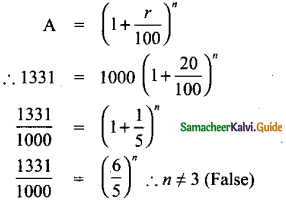
(v) The compound interest on ₹ 16000 for 9 months at 20% p.a, compounded quarterly is ₹ 2522.
Answer:
True
Hint:
Principal (P) = 16000
n = 9 months = \(\frac{9}{12}\) years
r = 20% p.a
For compounding quarterly, we have to use below formula,
Amount(A) = P × \(\left(1+\frac{r}{100}\right)^{4 n}\)
Since quarterly we have to divide ‘r’ by 4
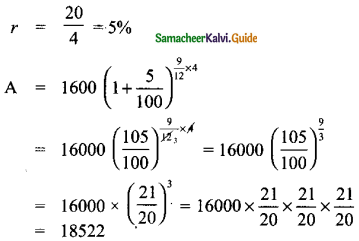
∴ Interest A – P = 18522 – 16000 = 2522 (True)
![]()
Question 3.
Find the compound interest on ₹ 3200 at 2.5 % p.a for 2 years, compounded annually.
Answer:
Principal (P) = ₹ 3200
r = 2.5% p.a
n = 2 years comp. annually
∴ Amount (A) = \(\left(1+\frac{r}{100}\right)^{n}\)
= 3200 \(\left(1+\frac{25}{100}\right)^{2}\)
= 3200 × (1.025)2 = 3362
Compound interest (CI) = Amount – Principal
= 3362 – 3200 = 162
Question 4.
Find the compound interest for 2\(\frac { 1 }{ 2 }\) years on ₹ 4000 at 10% p.a, if the interest is compounded yearly.
Answer:
Principal (P) = ₹ 4000
r = 10 %p.a
Compounded yearly
n = 2\(\frac { 1 }{ 2 }\) years. Since it is of the form a \(\frac{b}{c}\) years
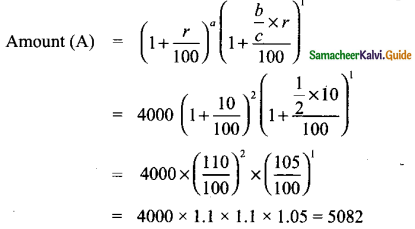
∴ CI = Amount – principal = 5082 – 4000 = 1082
![]()
Question 5.
A principal becomes ₹ 2028 in 2 years at 4% p.a compound interest. Find the principal.
Answer:
n = 2 years
r = rate of interest = 4% p.a
Amount A = ₹ 2028
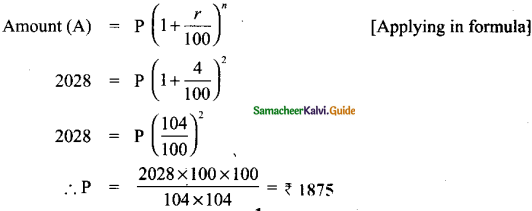
Question 6.
In how many years will ₹ 3375 become ₹ 4096 at 13 % p.a if the interest is compounded half-yearly?
Answer:
Principal = ₹ 3375
Amount = ₹ 4096
r = 13\(\frac{1}{3}\)%p.a = \(\frac{40}{3}\)%p.a

Let no. of years be n
for compounding half yearly, formula is
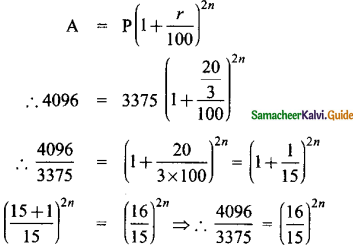
Taking cubic root on both sides,
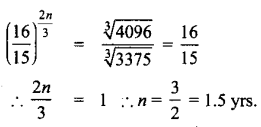

![]()
Question 7.
Find the CI on ₹ 15000 for 3 years if the rates of interest are 15%, 20% and 25% for the I, II and III years respectively.
Answer:
Principal (P) = ₹ 15000
rate of interest 1 (a) = 15% for year I
rate of interest 2 (b) = 20% for year II
rate of interest 3 (c) = 25% for year III
Formula for amount when rate of interest is different for different years is

Substituting in the above formula, we get

∴ Compound Interest(CI) = A – P = 25,875 – 15,000 = ₹ 10,875
CI = ₹ 10.875
Question 8.
Find the difference between C.I and S.I on ₹ 5000 for 1 year at 2% p.a, if the interest is compounded half yearly.
Answer:
Principal (P) = ₹ 5000
time period (n) = 1 yr.
Rate of interest (r) = 2%p.a
for half yearly r = 1%
Difference between CI & SI is given by the formula

![]()
Question 9.
Find the rate of interest if the difference between C.I and S.I on ₹ 8000 compounded annually for 2 years is ₹ 20.
Answer:
Principal (P) = ₹ 8000
time period (n) = 2 yrs.
rate of interest (r) = ?
Difference between CI & SI is given by the formula
CI – SI = \(p\left(1+\frac{r}{100}\right)^{n}\)
Difference between CI & SI is given as 20
∴ 20 = 8000 × \(\left(\frac{r}{100}\right)^{2}\)
∴ \(\left(\frac{r}{100}\right)^{2}=\frac{20}{8000}=\frac{1}{400}\)
Taking square root on both sides
\(\frac{r}{100}=\sqrt{\frac{1}{400}}=\frac{1}{20}\)
∴ r = \(\) = 5 %
Question 10.
Find the principal if the difference between C.I and S.l on it at 15% p.a for 3 years is ₹ 1134.
Answer:
Rate of interest (r) = 15% p.a
time period (n) = 3 years
Difference between CI & SI is given as 1134
Principal = ? → required to find
Using formula for difference
Simple Interest SI = \(\frac{P n r}{100}\)
Compound Interest CI = p(1 + i)n – p
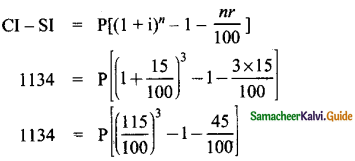
1134 = P[(1.15)3 – 1 – 0.45] = P(1.52 – 1.45) = P (0.07)
∴ p = \(\frac{1134 \times 100}{0.07 \times 100}=\frac{113400}{7}\)
P = ₹ 16200
![]()
Objective Type Questions
Question 11.
The number of conversion periods in a year, if the interest on a principal is compounded every two months is _________ .
(A) 2
(B) 4
(C) 6
(D) 12
Answer:
(C) 6
Hint:
Conversion period is the time period after which the interest is added to the principal. If principal is compounded every two months then in a year, there will be 6\(\left(\frac{12}{2}\right)\) conversion periods.
Question 12.
The time taken for ₹ 4400 to become ₹ 4851 at 10%, compounded half yearly is _________ .
(A) 6 months
(B) 1 year
(C) 1\(\frac{1}{2}\) years
(D) 2 years
Answer:
(B) 1 year
Hint:
Principal = ₹ 4400
Amount = ₹ 4851
Rate of interest = 10% p.a
for half yearly, divide by 2,
r = \(\frac{10}{2}\) = 5 %
Compounded half yearly, so the formula is
A = P\(P\left(1+\frac{r}{100}\right)^{2 n}\)
Substituting in the above formula, we get
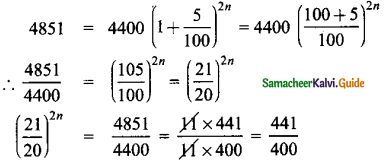
Taking square root on both sides, we get
\(\left(\frac{21}{20}\right)^{2 n}=\left(\frac{21}{20}\right)^{2}\)
Equating power on both sides
∴ 2n = 2, n = 1
![]()
Question 13.
The cost of a machine is ₹ 18000 and it depreciates at 16\(\frac{2}{3}\)% annually. Its value after 2 years will be _________ .
(A) ₹ 2000
(B) ₹ 12500
(C) ₹ 15000
(D) ₹ 16500
Answer:
(B) ₹ 12500
Hint:
Cost of machine = 18000
Depreciation rate = 16\(\frac{2}{3}\)% = \(\frac{50}{3}\)%p.a
time period = 2 years
∴ As per depreciation formula,
Depriciated value = Original value \(\left(1-\frac{r}{100}\right)^{n}\)
Substituting in above formula, we get
Depreciated value after 2 years
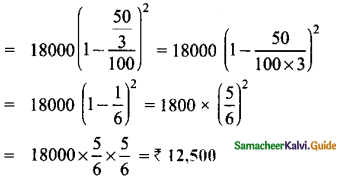
Question 14.
The sum which amounts to ₹ 2662 at 10% p.a in 3 years, compounded yearly is _________ .
(A) ₹ 2000
(B) ₹ 1800
(C) ₹ 1500
(D) ₹ 2500
Answer:
(A) ₹ 2000
Hint:
Amount = ₹ 2662
rate of interest = 10 % p.a
Time period = 3 yrs. Compounded yearly
Principal (P) → required to find?
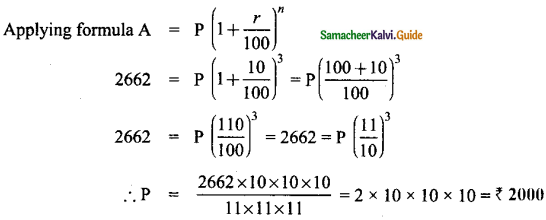
![]()
Question 15.
The difference between compound and simple interest on a certain sum of money for 2 years at2%p.ais U. The sum of money is _________ .
(A) ₹ 2000
(B) ₹ 1500
(C) ₹ 3000
(D) ₹ 2500
Answer:
(D) ₹ 2500
Hint:
Difference between CI and SI is given as Re I
Time period (n) = 2 yrs.
Rate of interest (r) = 2 % p.a
Formula for difference is
CI – SI = \(P \times\left(1+\frac{r}{100}\right)^{n}\)
Substituting the values in above formula, we get
1 = p × \(\left(\frac{2}{100}\right)^{2}\)
∴ p = 1 × \(\left(\frac{100}{2}\right)^{2}\) = 1 × (50)2 = ₹ 2500